英语中形容词用法专题精讲
- 格式:ppt
- 大小:595.50 KB
- 文档页数:56
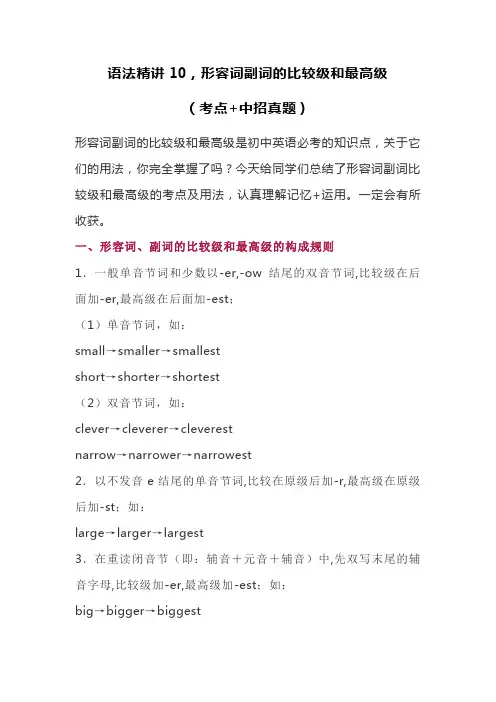
语法精讲10,形容词副词的比较级和最高级(考点+中招真题)形容词副词的比较级和最高级是初中英语必考的知识点,关于它们的用法,你完全掌握了吗?今天给同学们总结了形容词副词比较级和最高级的考点及用法,认真理解记忆+运用。
一定会有所收获。
一、形容词、副词的比较级和最高级的构成规则1.一般单音节词和少数以-er,-ow结尾的双音节词,比较级在后面加-er,最高级在后面加-est;(1)单音节词,如:small→smaller→smallestshort→shorter→shortest(2)双音节词,如:clever→cleverer→cleverestnarrow→narrower→narrowest2.以不发音e结尾的单音节词,比较在原级后加-r,最高级在原级后加-st;如:large→larger→largest3.在重读闭音节(即:辅音+元音+辅音)中,先双写末尾的辅音字母,比较级加-er,最高级加-est;如:big→bigger→biggesthot→hotter→hottestfat→fatter→fattest4.以“辅音字母+y”结尾的双音节词, 把y改为i,比较级加-er,最高级加-est;如:easy→easier→easiestheavy→heavier→heaviest5.其他双音节词和多音节词,比较级在前面加more,最高级在前面加most;如:beautiful→more beautiful→most beautifuldifferent→more different→most differenteasily→more easily→most easily注意:(1)形容词最高级前通常必须用定冠词 the,副词最高级前可不用.The Sahara is the biggest desert in the world.(2)形容词most前面没有the,不表示最高级的含义,只表示"非常".It is a most important problem.=It is a very important problem.6.有少数形容词、副词的比较级和最高级是不规则的,必须熟记。
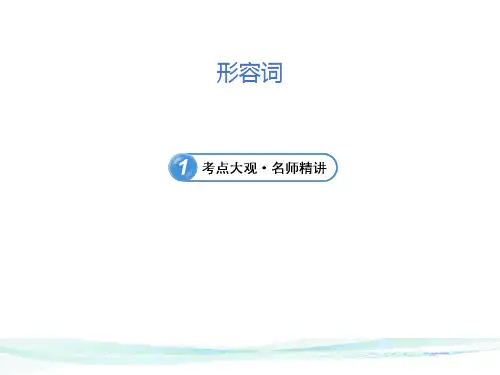

高三英语形容词、副词、介词、连词【本讲主要内容】英语语法基础知识:形容词、副词、介词、连词【知识总结归纳】1. 形容词:表示名词的性质和特征的词叫做形容词,形容词可以用作定语、表语、宾语补足语和状语等。
(1)在使用形容词时要注意它的原级、比较级和最高级。
注意一般形容词比较级是:原级+—er,最高级是,原级+—est;部分双音节及多音节形容词的比较级是:more+原级,最高级为most+原级。
如:nice—nicer—nicest,beautiful—more beautiful / —most beautiful少数形容词的比较级和最高级的变化不规则。
如:goodwellbetter bestmanymuchmore mostbad worse worstlittle less leastfar farther farthest further furthestoldolder oldestelder eldest ⎫⎬⎭⎫⎬⎭⎧⎨⎩⎧⎨⎩——————————————(2)形容词比较级可以有even, much, many, a bit, still, a little等状语来修饰。
如:Millions of other stars are even bigger and brighter than the sun. They look small only because they are much farther away.In fact, the earth is a bit nearer to the sun during our winter.(3)注意能分析出与形容词比较等级有关的句型。
①……than…………比……Is their room larger than ours?②最……These three parks are all very beautiful, but this one is the most beautiful of the three.③……与……一样……as……as……Chinese is as important as maths.④……不如…………not so(as)……as……Making model boats isn’t as difficult as making model planes.Wang Ping is not so tall as Li Ping.⑤最……之一…… one of / among the……The Changjiang River is among the longest rivers in the world.⑥越来越……形容词比较级+and+形容词比较级Soon autumn came and it became colder and colder.⑦第……最…… 序数词+最高级Africa is the second largest continent.⑧越……越…… the +比较级……,the+比较级……The farther away the feeding place was, the slower the dance was.The more you practice, the better you pronounce.⑨尽可能…… as+原级+as possibleThe old men and the boys made the wounded as comfortable as possible.(4)下列词一般只用作表语,不用作定语。

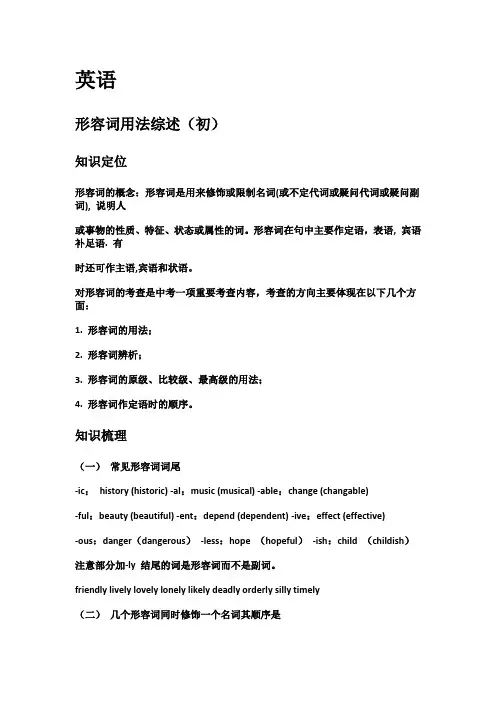
英语形容词用法综述(初)知识定位形容词的概念:形容词是用来修饰或限制名词(或不定代词或疑问代词或疑问副词), 说明人或事物的性质、特征、状态或属性的词。
形容词在句中主要作定语,表语, 宾语补足语. 有时还可作主语,宾语和状语。
对形容词的考查是中考一项重要考查内容,考查的方向主要体现在以下几个方面:1. 形容词的用法;2. 形容词辨析;3. 形容词的原级、比较级、最高级的用法;4. 形容词作定语时的顺序。
知识梳理(一)常见形容词词尾-ic:history (historic) -al:music (musical) -able:change (changable)-ful:beauty (beautiful) -ent:depend (dependent) -ive:effect (effective)-ous:danger(dangerous)-less:hope (hopeful)-ish:child (childish)注意部分加-ly 结尾的词是形容词而不是副词。
friendly lively lovely lonely likely deadly orderly silly timely(二)几个形容词同时修饰一个名词其顺序是1. 限定词(all、both、such、a(an)、the、Tom’s、my、your、this 等)2. 数量形容词(序数词在前,基数词在后)3. ᧿述性形容词(音节少的在前,音节多的在后):如:fine,good,sick,soft,kind,lovely,ugly,dirty,heavy,stupid,interesting 等4. 大小、长短、高低、形状(通常大小在前,形状在后)5. 新旧,老幼,温度6. 颜色7. 国籍8. 材料9. 用途、类别(通常是动名词或名词,有时也有形容词。
)10. 最后才是名词如five beautiful large black Italian winter coats (234679)two fat middle-aged American doctors (2457)(三)形容词的比较级和最高级1)单音节和部分双音节词(以-er,-ow,-y)(ly 除外)结尾的词,一般直接加er,est yellowyellower tall taller tallest2)以-e 结尾的单词,直接加r,st large larger largest;3)闭音节单音节词,若末尾只有一个辅音字母,要双写这个辅音字母,然后再加-er,-estbig bigger biggest4)以辅音字母加y 结尾的单音节和部分双音节词(以-ly 后缀的词除外)要去y 加ier iestearly earlier earliest5)不规则变化good/ well(身体好) beeter bestbad/ ill worse worestmany/ much more mostlittle less leastfar farther farthest (具体意义;更远,最远)far further further(抽象意义;)old older/ elder olest/ eldest6)两者比较要用比较级“比较级+than”或“less(more)…than”比较级前可用“far,much,even,still,a little,a lot a bit”修饰,表示程度Mike is a little taller than Bob比较级+比较级,表示越来越Our life is better and better.Shanghai is becoming more and more beautiful.the +比较级,the +比较级,表示越……就越……The sooner,the better.7)三者或三者以上比较要用最高级,可用the+最高级+比较范围(of/in/among+范围)Wales are the largest animals in the world.one of +the+形容词最高级+名词复数,表示“最……之一”one of the oldest contries in the world8)as…as;not as/so…as 表示同级比较“与…一样”“不及…”考点注意:1. 原级,比较级,最高级三者的转换。
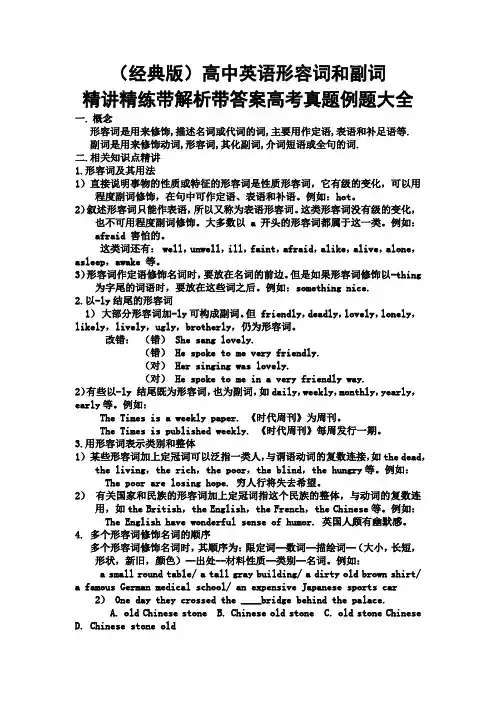
(经典版)高中英语形容词和副词精讲精练带解析带答案高考真题例题大全一.概念形容词是用来修饰,描述名词或代词的词,主要用作定语,表语和补足语等.副词是用来修饰动词,形容词,其化副词,介词短语或全句的词.二.相关知识点精讲1.形容词及其用法1)直接说明事物的性质或特征的形容词是性质形容词,它有级的变化,可以用程度副词修饰,在句中可作定语、表语和补语。
例如:hot。
2)叙述形容词只能作表语,所以又称为表语形容词。
这类形容词没有级的变化,也不可用程度副词修饰。
大多数以a开头的形容词都属于这一类。
例如:afraid 害怕的。
这类词还有: well,unwell,ill,faint,afraid,alike,alive,alone,asleep,awake 等。
3)形容词作定语修饰名词时,要放在名词的前边。
但是如果形容词修饰以-thing 为字尾的词语时,要放在这些词之后。
例如:something nice.2.以-ly结尾的形容词1)大部分形容词加-ly可构成副词。
但 friendly,deadly,lovely,lonely,likely,lively,ugly,brotherly,仍为形容词。
改错:(错) She sang lovely.(错) He spoke to me very friendly.(对) Her singing was lovely.(对) He spoke to me in a very friendly way.2)有些以-ly 结尾既为形容词,也为副词,如daily,weekly,monthly,yearly,early等。
例如:The Times is a weekly paper. 《时代周刊》为周刊。
The Times is published weekly. 《时代周刊》每周发行一期。
3.用形容词表示类别和整体1)某些形容词加上定冠词可以泛指一类人,与谓语动词的复数连接,如the dead,the living,the rich,the poor,the blind,the hungry等。

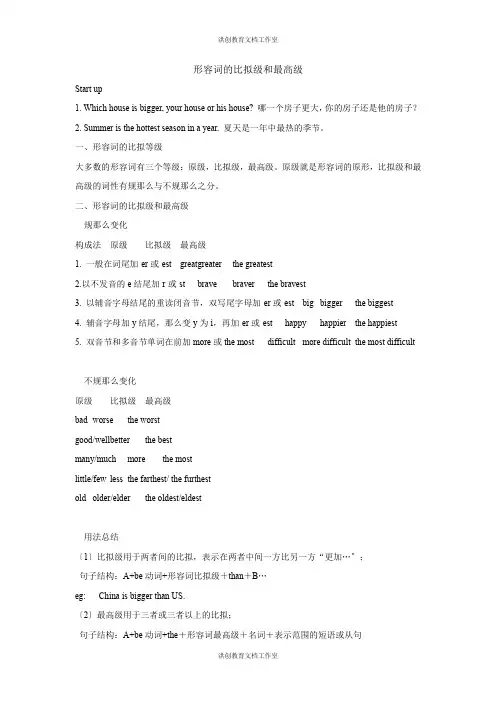
形容词的比拟级和最高级Start up1. Which house is bigger, your house or his house? 哪一个房子更大,你的房子还是他的房子?2. Summer is the hottest season in a year. 夏天是一年中最热的季节。
一、形容词的比拟等级大多数的形容词有三个等级:原级,比拟级,最高级。
原级就是形容词的原形,比拟级和最高级的词性有规那么与不规那么之分。
二、形容词的比拟级和最高级规那么变化构成法原级比拟级最高级1. 一般在词尾加-er或-est greatgreater the greatest2.以不发音的e结尾加-r或-st brave braver the bravest3. 以辅音字母结尾的重读闭音节,双写尾字母加-er或-est big bigger the biggest4. 辅音字母加y结尾,那么变y为i,再加-er或-est happy happier the happiest5. 双音节和多音节单词在前加more或the most difficult more difficult the most difficult不规那么变化原级比拟级最高级bad worse the worstgood/wellbetter the bestmany/much more the mostlittle/few less the farthest/ the furthestold older/elder the oldest/eldest用法总结〔1〕比拟级用于两者间的比拟,表示在两者中间一方比另一方“更加…〞;句子结构:A+be动词+形容词比拟级+than+B…eg: China is bigger than US.〔2〕最高级用于三者或三者以上的比拟;句子结构:A+be动词+the+形容词最高级+名词+表示范围的短语或从句(如all, of all, of the tree, in the world, that has ever taken place等)。
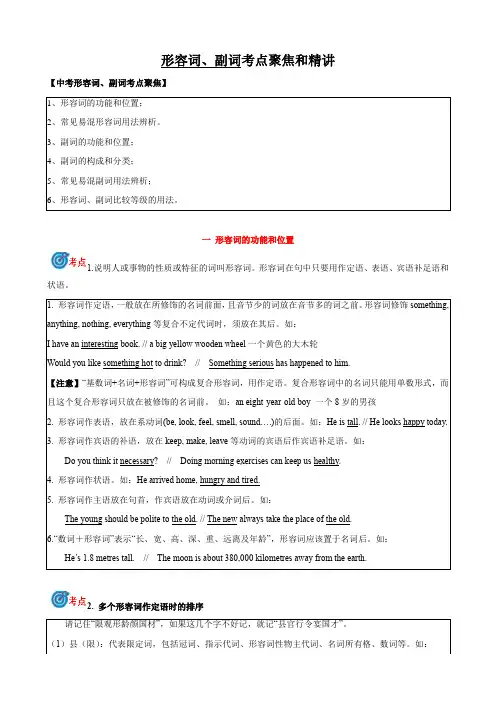
形容词、副词考点聚焦和精讲【中考形容词、副词考点聚焦】一形容词的功能和位置1.说明人或事物的性质或特征的词叫形容词。
形容词在句中只要用作定语、表语、宾语补足语和状语。
2. 多个形容词作定语时的排序There is a small old black wooden desk in my room. 在我的房间里有一个又小又旧的黑色木桌。
His living room is decorated with a large green Chinese carpet. 他的起居室里装饰着绿色的中国大地毯。
3. the加上某些形容词相当于名词,表示一类人或事物The poor are very happy, but the rich are sad. 穷人高兴,但是富人悲伤。
4. 以-ly结尾的形容词5. 只能作表语的形容词:6. 只能作定语的形容词:7. 既可做形容词又可做副词的词8. 形容词与名词的转换:(1)名词加后缀变为形容词。
(2)形容词加后缀变为名词。
9. -ing形容词和-ed形容词的比较:-ing形容词表示主动意义,多修饰事或物,多指事物影响到人,意为“使人(感到)……的”;而-ed 形容词往往带有被动含义,修饰人,多指人受到事物的影响,意为“感到……的”,常用于“sb.+ -ed形容词”结构,有时也做定语用。
10. 形容词常用句型:二常用易混形容词用法辨析:(1)whole与all的用法辨析:记住两个词序:① the whole +名词;①all (of) the +名词。
如:He was busy the whole morning.He can remember all the words he learns.(2)tall与high, short与low用法辨析:指人的个子时用tall与short;指其他事物时一般用high 与low。
He’s very tall/short. // A few people live on high mountains.Tall trees are standing on both sides of that avenue.(3)real与true的用法辨析:real一般指东西的真假,意为“真的”;而true则指事情或消息的可靠性,意为“真实的”。
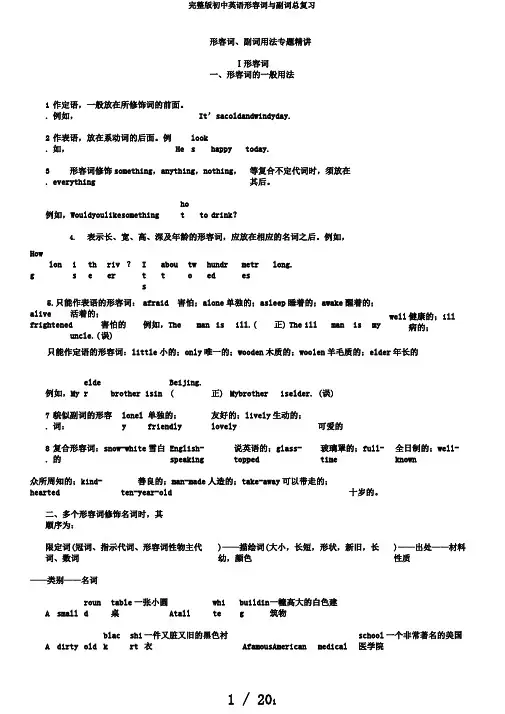
形容词、副词用法专题精讲Ⅰ形容词一、形容词的一般用法1 .作定语,一般放在所修饰词的前面。
例如,It’sacoldandwindyday.2 .作表语,放在系动词的后面。
例如,Helooks happy today.3 .形容词修饰something,anything,nothing,everything等复合不定代词时,须放在其后。
例如,Wouldyoulikesomething hot to drink?4.表示长、宽、高、深及年龄的形容词,应放在相应的名词之后。
例如,Howlon g istheriver?Itsabouttwohundredmetreslong.5.只能作表语的形容词:afraid 害怕;alone单独的;asleep睡着的;awake醒着的;alive 活着的;frightened 害怕的例如,The man is ill.( 正) The ill man is my uncle.( 误)well 健康的;ill病的;只能作定语的形容词:little小的;only唯一的;wooden木质的;woolen羊毛质的;elder年长的例如,My elder brother isinBeijing.(正)Mybrother iselder.(误)7 .貌似副词的形容词:lonely单独的;friendly友好的;lively生动的;lovely可爱的8 .复合形容词:snow-white雪白的English-speaking说英语的;glass-topped玻璃罩的;full-time全日制的;well-known众所周知的;kind-hearted善良的;man-made人造的;take-away可以带走的;ten-year-old十岁的。
二、多个形容词修饰名词时,其顺序为:限定词(冠词、指示代词、形容词性物主代词、数词)——描绘词(大小,长短,形状,新旧,长幼,颜色)——出处——材料性质——类别——名词A small roundtable一张小圆桌Atallwhitebuilding一幢高大的白色建筑物A dirty old blackshirt一件又脏又旧的黑色衬衣AfamousAmerican medicalschool一个非常著名的美国医学院三、形容词常用句型“It’s+adj.+of+sb.+不定式〞表示“某人(做某事)怎么样〞。
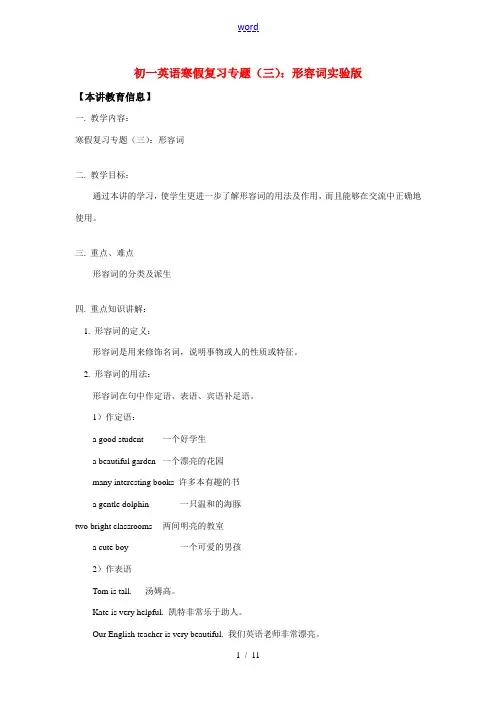
初一英语寒假复习专题(三):形容词实验版【本讲教育信息】一. 教学内容:寒假复习专题(三):形容词二. 教学目标:通过本讲的学习,使学生更进一步了解形容词的用法及作用,而且能够在交流中正确地使用。
三. 重点、难点形容词的分类及派生四. 重点知识讲解:1. 形容词的定义:形容词是用来修饰名词,说明事物或人的性质或特征。
2. 形容词的用法:形容词在句中作定语、表语、宾语补足语。
1)作定语:a good student 一个好学生a beautiful garden 一个漂亮的花园many interesting books 许多本有趣的书a gentle dolphin 一只温和的海豚two bright classrooms 两间明亮的教室a cute boy 一个可爱的男孩2)作表语Tom is tall. 汤姆高。
Kate is very helpful. 凯特非常乐于助人。
Our English teacher is very beautiful. 我们英语老师非常漂亮。
A panda is cute and gentle. 熊猫是可爱的和温和的。
Jim and Kate are happy to see their parents.吉姆和凯特见到他们的父母非常高兴。
3)作宾语补足语I find English interesting. 我发现英语有意思。
You make our English class interesting. 你使我们的英语课有趣。
It can make you fat. 它会使你发胖。
4)形容词在句中的位置:①形容词作定语一般放在被修饰的名词之前,如果有两个以上的形容词修饰一个名词时,则由它们和被修饰的名词之间的密切程度而定,越密切的形容词越靠近名词,如果几个形容词的密切程度差不多,则按音节少的形容词放在前面,音节多的形容词放在后面。
②形容词在修饰不定代词something, nothing和anything时,则放在后面,例如:something nice, nothing new…等。
中考英语语法精讲例析形容词副词中考英语语法精讲例析形容词副词(一) 知识概要形容词的用法很活跃,在英语中用处也很多,但英语中修饰可数名词和不可数名词的修饰语和词组有时不同,要特别加以注意。
下面将初中学习阶段中遇到的修饰可数名词的词和词组归纳如下:an, n, several, se, a fe, a lt, lts, plent, plent f, a lt f, a large nuber f, enugh。
而修饰不可数名词的词或词组如下:uh, n, se, a lt, a great deal, lts, plent, a lt f, plent f。
其中se, n, a lt f, plent f既可修饰可数名词又可修饰不可数名词。
英语中形容词与副词有原级、比较级、最高级之分,其规则如下:构词法原级比较级最高级加er,或est Tallungertallestungest只加r或largenierlargerlargest重读闭音节末尾只有一个辅音字母时双写该字母加er、htbiggerfatterhtterfattesthttest不规则变化的形容词或副词:原级比较级最高级gd better best ell better best bad rse rst badl rse rst an re stst re stlittle less lest far farther further farthest furthesteldereldest要注意的是许多形容词同时又是副词,如:ba, all, alne, either, far, high, sl等。
而有些形容词则要经过一定变化才能转为副词,其规律如下:构词法形容词副词一般加l arefulindindl尾是时将变成i加l Happ buseasHappilbusileasil其他truefull pssible shhle trul terribl full pssibl shlhll在学习过程中要注意其变化。
形容词一、考点梳理考点一形容词的用法及位置1. 形容词的用法(1) 形容词是用来描述或修饰名词(或代词)的一类词。
形容词在句中作定语、表语、宾语补足语、状语、主语或宾语等成分。
Peter is tall. 彼得个子高。
(作表语)We must keep our classroom clean.我们必须保持我们的教室干净。
(作宾语补足语)She has short hair. 她留短发。
(作定语)The girl went to school, cold and hungry.那个女孩又冷又饿地去上学了。
(作状语)The rich should help the poor.富人应当帮助贫穷的人。
(作主语和宾语)(2) 多个形容词修饰一个名词时,其顺序为:限定词(冠词、指示代词等)+ 数词+ 描述性形容词+ 大小、长短、高低等形容词+ 形状+ 新旧+ 颜色+ 国籍+ 材料性质+ 用途类别。
巧记:多个形容词作定语的顺序口诀限定描述大长高,形状年龄与新老;颜色国籍出材料,用途类别往后靠。
a small round table 一张小圆桌a dirty old brown shirt一件又脏又旧的棕色衬衣(3) 某些形容词加上定冠词可以泛指一类人,谓语动词用复数,如:the dead, the living, the rich, the poor, the blind 等。
The poor are in great need of help.穷人们非常需要帮助。
(4) 有关国家和民族的形容词加上定冠词指这个民族的整体,谓语动词用复数,如:the British, the English, the French, the Chinese等。
The Chinese are hard-working.中国人是勤奋努力的。
2. 形容词的位置(1) 形容词作定语时一般放在被修饰词的前面。
I think it’s an interesting book.我觉得这是一本有趣的书。
【一轮复习讲义】2024年高考英语高频考点题型归纳与方法总结(新高考通用)第05讲形容词和副词(精讲)题型目录一览1.形容词的基本用法在句中可作定语、表语、宾语补足语、主语补足语、状语等。
一般情况下,单个的形容词作定语放在被修饰的词之后,形容词短语放在被修饰的词之前。
He is the only man alive in the village after the earthquake.地震后他是那个村子里唯一活着的人。
It is a problem difficult to solve.这是个难以解决的问题。
■名师点津(1)形容词作状语主要表示原因、结果或伴随等,其逻辑主语必须与句子主语保持一致。
Light-hearted and optimistic, she is the sort of woman to spread sunshine to people through her smile.她无忧无虑、积极乐观,是那种用微笑给别人带来快乐的人。
(2)有些以-ly结尾的词是形容词,而不是副词。
常见的有:friendly, lovely, lively, lonely, elderly, deadly 等。
2.副词的基本用法(1) 副词主要用来修饰动词、形容词或其他副词,表示时间、地点、程度、方式等。
(2019·天津卷)A dog’s eating habit requires regular training before it is properly established.狗的饮食习惯在正确建立之前需要定期的训练。
■名师点津有些副词,如fortunately, luckily, surprisingly, honestly, actually, personally等作评注性状语,往往修饰整个句子,而且它们常位于句首,且有逗号与后面的句子分开。
(安徽卷)Thankfully, I managed to get through the game and the pain was worth it in the end.谢天谢地,我终于打完比赛了,所有的辛苦最终都是值得的。
专题04形容词和副词知识精讲一、形容词和副词的基本用法(一)形容词在句中的作用1.形容词在句中可作定语、表语和补语①形容词作定语时的位置问题:通常放置被修饰的名词前,但是下列情况需后置:▲形容词短语作定语This is a language difficult to master.这是一门难以掌握的语言。
In the distance there is a leaning tower about 180 feet high.远处有一座180英尺的斜塔。
He is a student worth of praise.他是个值得表扬的学生。
▲表语形容词(参考下列3)作定语He is indeed a Lei Feng alive.他真是个活雷锋。
▲形容词修饰不定代词Someone strange is asking to see you.有个陌生人要见你。
Something unexpected happened and we had to make some changes to our plan.发生了一些意想不到的事情,我们不得不对我们的计划做些改变。
▲else修饰疑问代词和不定代词No one else can answer the question.其他没有人能回答这个问题。
What else do you want to say? 你想还说点什么?②多个形容词作定语时的词序为:大小、长短、高低形状/年龄、新旧颜色/来源、国籍、地区、出处/材料/用途(熟记下列顺口溜:限定描绘大长高,形状年龄和新老,颜色国籍跟材料,作用类别往后靠)。
It’s a _______ clock, made of brass and dating from the nineteenth century.A. charming French smallB. French small charmingC. small French charmingD. charming small French【答案与解析】D。